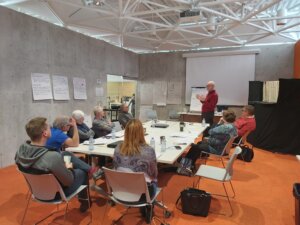Author: Peter Cantelon, Executive Director
I have always believed that there is no such thing as sustain in any organization be that a for-profit or non-profit business.
If you are not moving forward, growing, developing, and innovating, you are sliding backward. One of the reasons I believe this is that the work of a non-profit never ends until the core concern the organization was created for is resolved or the organization fails.
Given the nature of focus for the average non-profit (issues of social benefit such as ending homelessness, food insecurity, health and well-being etc.) it is rare that these areas of concern are resolved quickly.
“Well, this cannot be a concern of ours right now, we are too busy working on the core concerns of our mission and mandate to do something as frivolous as innovate.”
But are we?
Often what feels productive is merely reacting to the overwhelming tidal wave of need that confronts us daily as we seek to simply meet said need with our very limited resources.
This is an important effort that must be done but should not be confused with growth and innovation. Reacting is a form of sustaining. Reacting is putting a finger in the dike to stop the flood instead of building the dike higher or, innovating and developing a network of windmills that operate pumps to drain the impending flood waters.
The brilliant thing about non-profits is that they exist in one of the most fertile grounds for innovation – necessity. We see need everywhere and we breathe it daily. The old saying necessity is the mother of invention exists for a reason – because it is out of necessity that some of the most innovative ideas arise. It is the difference between quickly wrapping a loose joint in duct tape versus 3d printing a new and permanent joint that eliminates the problem for ever.

But in order to effectively innovate we must find the time to step back from the busyness of reacting and look at our concerns, needs and goals from a distance. We must gain perspective. Being in react mode makes this difficult. The average non-profit employee says –
“I would love to have the luxury to take a few hours a week to plan and innovate but I have to be at the counter in the food cupboard because we don’t have the resources to do otherwise.”
This may be true but it is also a bit of a mind trap. If you can come to view innovation as important as the services you deliver you may be surprised at the time that opens up. To put it another way – the goal of innovation is to be able to better and more creatively meet your objectives with fewer resources. The point of innovation is to overcome obstacles and move forward.
In this sense innovation may be more important than your 10 hours a week on the front line because given the time and your experience and expertise (not to mention the collaboration with others) you may be able to develop innovative ways to double your ability to meet needs AND even start working proactively to reduce the need.
But you need time to innovate. Innovation looks like lots of things – innovation looks like new tools, it looks like collaboration with unlikely partners, it looks like new and better policy and procedure, it looks like creative advocacy and utilization of tools and technology…it looks like having the time to network and communicate with peers in the sector and a pooling of resources.
All of this takes time but I guarantee you it is worth it and it is possible when you come to see this work not as a luxury but as valuable to the community you serve as the socks you hand out in winter – even moreso if that time leads to innovative new methods that reduce the need in the first place.
So what am I saying? Do not feel guilty about taking the time to plan and innovate. The question you must ask yourself is not “Can I afford to take this time?” but rather “Can I afford NOT to take this time?”